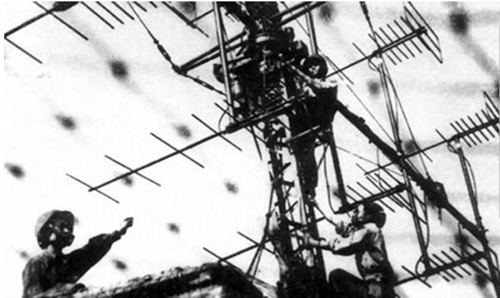Especially, the Vietnamese force successfully created an anti-interference technology to detect B-52s, marking a milestone in the victory of the campaign.
Why did Radar Regiment 291 rush to Nghe An?
Radar Regiment 291 was in charge of radar guidance and indicating targets for air defense operations in Hanoi and the North. In 1967, the unit excellently implemented the anti-jamming task to find U.S. aircraft in five large-scale operations, helping the air defense force shoot down a lot of the enemy jets.
    |
 |
|
Hero of the People’s Armed Forces, Senior Colonel Nghiem Dinh Tich (second from left) during an event in celebration of the 50th anniversary of the "Hanoi - Dien Bien Phu in the air" victory |
The question is Why was the regiment mobilized to Nghe An province in early November 1972 while it was protecting Hanoi and Hai Phong?
Directly taking part in the Hanoi - Hai Phong air defense campaign in December 1972, Senior Colonel Nghiem Dinh Tich held that from 1966 to 1972, the ADAF sent missile, radar, air force, electronic reconnaissance units and “B working groups” to the battlefield in Military Region 4 to both join the campaign while studying how to defeat B-52s.
Studying the operations of the B-52, leaders of the radar corps concluded that the B-52 would attack Hanoi via two directions: From Guam through the East Sea (South China Sea) to the southeast of Hanoi and from U Tapao Airport (Thailand) through Laos to the northwest of Hanoi. Therefore, Nghe An province was an ideal destination to detect the B-52 early, especially when its radars were jammed. With its experience, the regiment was sent to Nghe An to implement the task, helping the air defense force defeat B-52s.
Unlike the anti-aircraft artillery, missile and air force regiments which were tasked with only tactical missions, Radar Regiment 291 also carried out operational and strategic levels. After rushing to Nghe An, the regiment quickly built operation plans and prepared two core Companies 45 and 16 for the campaign, of which Company 45 had been on duty in Nghe An since 1969.
Anti-jamming “journey” against B-52s
The mobilization of Radar Regiment 291 to Nghe An was a strategic decision. However, they were also facing a difficult task of how to detect stealth B-52s.
    |
 |
|
On December 18, 1972, radar troops detect B-52s 35 minutes early and from afar. |
The unit quickly studied the operation, characteristics, advantages and disadvantages of the B-52 so as to find out how to conduct an anti-jamming operation of B-52 via radar stations. However, at that time, most of the radar stations only had one transmitter and one receiver, which were meter and decimeter wavelength devices, so it was very difficult to effectively carry out the new task.
“During the first struggle against the enemy's destructive campaign, Company 45 was equipped with four radar stations, including two radar stations (P35, PRV-11) for air force guidance; two warning radar stations (P15, P12) for navigation. By the end of 1972, the company had had only two radar stations P35 and P12. Radio P15 was sent to another unit, while the PRV-11 altimeter was hit by enemy’s Shrike missiles on November 22, 1972,” said Senior Colonel Nghiem Dich Tich.
Company 45 was mobilized to Nghe An from late 1969 and tasked with ensuring guidance for the air force on the battlefield of Region 4. During its task performance, the unit focused on studying B-52 since it attacked the area of the Ho Chi Minh Road and then moved to Nghe An, thereby, grasping the U.S. aircraft directions, jamming characteristics, and the anti-jamming ability of Radar Station P35. The company then found out the anti-jamming solution.
Especially, on December 18, 1972, on the screen of Company 45 appeared interference of B-52s. The farthest B-52 group was about 220km South of Doi Si battlefield (Do Luong district, Nghe An). Immediately, observers number 1 and 2 quickly announced the target. Receiving intelligence information related to B-52, Comrade Hua Manh Tai, Deputy Chief of Staff of the radar corps, directed Company 45 to verify the information. At that time, Senior Colonel Nghiem Dinh Tich confirmed the information.
Accordingly, an officer on duty at the ADAF’s headquarters informed ADAF Commander Le Van Tri that B-52s were flying over Latitude 20, and about to hit Hanoi. Immediately, Commander Le Van Tri ordered the whole unit to be ready to fight B-52s.
During the Hanoi - Hai Phong air defense campaign in December 1972, the radar force, especially Company 45, detected B-52 35 minutes early and from afar, thereby alerting Hanoi’s air defense troops to be ready in any circumstances. As a result, eight U.S. aircraft, including three B-52s, were shot down on the first day of the campaign on December 18. During the key battle on December 20, the air defense force downed seven more B-52s. On December 26, 18 other aircrafts, including eight B-52s, were defeated.
According to Senior Colonel Nghiem Dinh Tich, the ADAF also instructed the anti-jamming task in other army corps and forces.
Regarding the air defense force, in addition to fighting B-52s in Hanoi, its MiG-21 also attacked the enemy from the outside such as Yen Bai, Cam Thuy (Thanh Hoa province), approached and hit the B-52. Meanwhile, the signal troops developed a plan to use the Voice of Vietnam FM communication network to replace the information network when it was heavily interfered with. Besides, the ADAF closely worked with other functional agencies to use their telecommunication networks in order to directly connect with relevant units in need.
Translated by Minh Anh